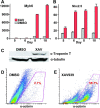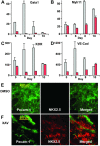Cardiac induction of embryonic stem cells by a small molecule inhibitor of Wnt/β-catenin signaling
- PMID: 21077691
- PMCID: PMC3076310
- DOI: 10.1021/cb100323z
Cardiac induction of embryonic stem cells by a small molecule inhibitor of Wnt/β-catenin signaling
Abstract
In vitro differentiation of embryonic stem cells is tightly regulated by the same key signaling pathways that control pattern formation during embryogenesis. Small molecules that selectively target these developmental pathways, including Wnt, and BMP signaling may be valuable for directing differentiation of pluripotent stem cells toward many desired tissue types, but to date only few such compounds have been shown to promote cardiac differentiation. Here, we show that XAV939, a recently discovered small molecule inhibitor of Wnt/β-catenin signaling, can robustly induce cardiomyogenesis in mouse ES cells. Our results suggest that a timely administration of XAV939 immediately following the formation of mesoderm progenitor cells promotes cardiomyogenic development at the expense of other mesoderm derived lineages, including the endothelial, smooth muscle, and hematopoietic lineages. Given the critical role that Wnt/β-catenin signaling plays in many aspects of embryogenesis and tissue regeneration, XAV939 is a valuable chemical probe to dissect in vitro differentiation of stem cells and to explore their regenerative potential in a variety of contexts.
Figures




Similar articles
-
Temporal modulation of β-catenin signaling by multicellular aggregation kinetics impacts embryonic stem cell cardiomyogenesis.Stem Cells Dev. 2013 Oct 1;22(19):2665-77. doi: 10.1089/scd.2013.0007. Epub 2013 Jun 14. Stem Cells Dev. 2013. PMID: 23767804 Free PMC article.
-
Small molecule Wnt inhibitors enhance the efficiency of BMP-4-directed cardiac differentiation of human pluripotent stem cells.J Mol Cell Cardiol. 2011 Sep;51(3):280-7. doi: 10.1016/j.yjmcc.2011.04.012. Epub 2011 May 4. J Mol Cell Cardiol. 2011. PMID: 21569778 Free PMC article.
-
Dorsomorphin, a selective small molecule inhibitor of BMP signaling, promotes cardiomyogenesis in embryonic stem cells.PLoS One. 2008 Aug 6;3(8):e2904. doi: 10.1371/journal.pone.0002904. PLoS One. 2008. PMID: 18682835 Free PMC article.
-
Wnt/β-catenin signaling in embryonic stem cell self-renewal and somatic cell reprogramming.Stem Cell Rev Rep. 2011 Nov;7(4):836-46. doi: 10.1007/s12015-011-9275-1. Stem Cell Rev Rep. 2011. PMID: 21603945 Review.
-
Wnt signaling in osteosarcoma.Adv Exp Med Biol. 2014;804:33-45. doi: 10.1007/978-3-319-04843-7_2. Adv Exp Med Biol. 2014. PMID: 24924167 Review.
Cited by
-
Stauprimide Priming of Human Embryonic Stem Cells toward Definitive Endoderm.Cell J. 2014 Feb 3;16(1):63-72. Epub 2014 Feb 3. Cell J. 2014. PMID: 24518969 Free PMC article.
-
Three-dimensional poly-(ε-caprolactone) nanofibrous scaffolds directly promote the cardiomyocyte differentiation of murine-induced pluripotent stem cells through Wnt/β-catenin signaling.BMC Cell Biol. 2015 Sep 3;16:22. doi: 10.1186/s12860-015-0067-3. BMC Cell Biol. 2015. PMID: 26335746 Free PMC article.
-
VUT-MK142 : a new cardiomyogenic small molecule promoting the differentiation of pre-cardiac mesoderm into cardiomyocytes.Medchemcomm. 2013 Aug 1;4(8):1189-1195. doi: 10.1039/C3MD00101F. Medchemcomm. 2013. PMID: 25045463 Free PMC article.
-
Functional cardiac tissue engineering.Regen Med. 2012 Mar;7(2):187-206. doi: 10.2217/rme.11.122. Regen Med. 2012. PMID: 22397609 Free PMC article. Review.
-
Robust cardiomyocyte differentiation from human pluripotent stem cells via temporal modulation of canonical Wnt signaling.Proc Natl Acad Sci U S A. 2012 Jul 3;109(27):E1848-57. doi: 10.1073/pnas.1200250109. Epub 2012 May 29. Proc Natl Acad Sci U S A. 2012. PMID: 22645348 Free PMC article.
References
-
- Fukuda K, Yuasa S. Stem cells as a source of regenerative cardiomyocytes. Circulation research. 2006;98:1002–1013. - PubMed
-
- Laflamme MA, Chen KY, Naumova AV, Muskheli V, Fugate JA, Dupras SK, Reinecke H, Xu C, Hassanipour M, Police S, O'Sullivan C, Collins L, Chen Y, Minami E, Gill EA, Ueno S, Yuan C, Gold J, Murry CE. Cardiomyocytes derived from human embryonic stem cells in pro-survival factors enhance function of infarcted rat hearts. Nature biotechnology. 2007;25:1015–1024. - PubMed
-
- Okita K, Ichisaka T, Yamanaka S. Generation of germline-competent induced pluripotent stem cells. Nature. 2007;448:313–317. - PubMed
-
- Okita K, Nakagawa M, Hyenjong H, Ichisaka T, Yamanaka S. Generation of mouse induced pluripotent stem cells without viral vectors. Science. 2008;322:949–953. - PubMed
-
- Takahashi K, Tanabe K, Ohnuki M, Narita M, Ichisaka T, Tomoda K, Yamanaka S. Induction of pluripotent stem cells from adult human fibroblasts by defined factors. Cell. 2007;131:861–872. - PubMed
Publication types
MeSH terms
Substances
Grants and funding
LinkOut - more resources
Full Text Sources
Other Literature Sources

